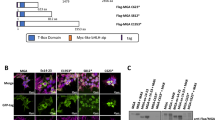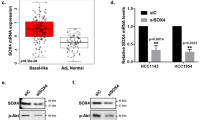Abstract
Expression of the transcription repressor Gfi-1 is required for the maintenance of murine hematopoietic stem cells. In human cells, ectopic expression of Gfi-1 inhibits and RNA interference-mediated Gfi-1 downregulation enhances proliferation and colony formation of p210BCR/ABL expressing cells. To investigate the molecular mechanisms that may explain the effects of perturbing Gfi-1 expression in human cells, Gfi-1-regulated genes were identified by microarray analysis in K562 cells expressing the tamoxifen-regulated Gfi-1-ER protein. STAT 5B and Mcl-1, two genes important for the proliferation and survival of hematopoietic stem cells, were identified as direct and functionally relevant Gfi-1 targets in p210BCR/ABL-transformed cells because: (i) their expression and promoter activity was repressed by Gfi-1 and (ii) when constitutively expressed blocked the proliferation and colony formation inhibitory effects of Gfi-1. Consistent with these findings, genetic or pharmacological inhibition of STAT 5 and/or Mcl-1 markedly suppressed proliferation and colony formation of K562 and CD34+ chronic myelogenous leukemia (CML) cells. Together, these studies suggest that the Gfi-1STAT 5B/Mcl-1 regulatory pathway identified here can be modulated to suppress the proliferation and survival of p210BCR/ABL-transformed cells including CD34+ CML cells.
This is a preview of subscription content, access via your institution
Access options
Subscribe to this journal
Receive 12 print issues and online access
$259.00 per year
only $21.58 per issue
Buy this article
- Purchase on Springer Link
- Instant access to full article PDF
Prices may be subject to local taxes which are calculated during checkout








Similar content being viewed by others
References
Friedman AD . Transcriptional control of granulocyte and monocyte development. Oncogene 2007; 26: 6816–6828.
Laslo P, Spooner CJ, Warmflash A, Lancki DN, Lee HS, Sciammes R et al. Multilineage transcriptional priming and determination of alternate hematopoietic cell fates. Cell 2006; 126: 755–766.
Chou ST, Khandros E, Baley LC, Nichols KE, Vakoc CR, Yao Y et al. Graded expression of PU1/Sfp1 gene transcription by GATA factors regulates hematopoietic cell fate. Blood 2009; 114: 983–994.
Sakamoto H, Dai G, Tsujino K, Huang X, Fujimoto T, Mucenski M et al. Proper levels of c-Myb are discretely defined at distinct steps of hematopoietic cell development. Blood 2006; 108: 896–903.
Zhang P, Iwasaki-Arai J, Iwasaki H, Fenyus ML, Dayaram T, Owens BM et al. Enhancement of hematopoietic stem cell repopulating capacity and self-renewal in the absence of the transcription factor C/EBPalpha. Immunity 2004; 21: 853–863.
Pabst T, Mueller BU . Transcriptional dysregulation during myeloid transformation in AML. Oncogene 2007; 26: 6829–6837.
Radomska HS, Huettner CS, Zhang P, Chen T, Scadden DT, Tenen DG . CCAAT/enhancer binding protein alpha is a regulatory switch sufficient for induction of granulocytic development from bipotential myeloid progenitors. Mol Cell Biol 1998; 18: 4301–4314.
Tenen DG . Disruption of differentiation in human cancer: AML shows the way. Nat Rev Cancer 2003; 3: 89–101.
Nerlov C . C/EBPα mutations in acute myeloid leukemias. Nat Rev Cancer 2004; 4: 394–400.
Perrotti D, Cesi V, Trotta R, Guerzoni C, Santilli G, Campbell K et al. BCR-ABL suppresses C/EBPα expression through inhibitory action of hnRNP E2. Nat Genet 2002; 30: 48–58.
Tavor S, Park DJ, Gery S, Vuong PT, Gombart AF, Koeffler HP . Restoration of C/EBPα exression in BCR-ABL+ cell line induces terminal granulocytic differentiation. J Biol Chem 2003; 278: 52651–52659.
Pabst T, Mueller BU, Harakawa N, Schoch C, Haferlach T, Behre G et al. AML1-ETO downregulates the granulocytic differentiation factor C/EBPalpha in t (8;21) myeloid leukemia. Nat Med 2001; 7: 444–451.
Ferrari-Amorotti G, Keeshan K, Zattoni M, Guerzoni C, Iotti G, Donato N et al. Leukemogenesis induced by wild-type and ST1571-resistant BCR/ABL is potently suppressed by C/EBPα. Blood 2006; 108: 1353–1362.
Keeshan K, Santilli G, Corradini F, Perrotti D, Calabretta B . Transcription activation function of C/EBPα is required for induction of granulocytic differentiation. Blood 2003; 102: 1267–1275.
Wang H, Iakova P, Wilde M, Welm A, Goode T, Roesler WJ et al. C/EBPalpha arrests cell proliferation through direct inhibition of Cdk2 and Cdk4. Mol Cell 2001; 8: 817–828.
Xu X, Lindberg B, Wewer UM, Friis-Hansen L, Nerlov C . E2F repression by C/EBPalpha is required for adipogenesis and granulopoiesis in vivo. Cell 2001; 107: 247–258.
Müller C, Calkhoven CF, Sha X, Leutz A . The CCAAT enhancer-binding protein alpha (C/EBPalpha) requires a SWI/SNF complex for proliferation arrest. J Biol Chem 2004; 279: 7353–7358.
D’Alo F, Johansen LM, Nelson EA, Radomska HS, Evans EK, Zhang P et al. The amino terminal of E 2F interaction domains are critical for C/EBP alpha-mediated induction of granulopoietic development of hematopoietic cells. Blood 2003; 102: 3163–3171.
Lidonnici MR, Audia A, Soliera AR, Prisco M, Ferrari-Amorotti G, waldron et al. Expression of the transcription repressor Gfi-1 is regulated by C/EBP(alpha) and is involved in its proliferation and colony formation-inhibitory effects in p210BCR/ABL-expressing cells. Cancer Res 2010; 70: 7949–7959.
Hock H, Haniblen MJ, Rooke HM, Schindler JW, Saleque S, Fujiwara Y et al. Gfi-1 restricts proliferation and preserves functional integrity of hematopoietic stem cells. Nature 2004; 431: 1002–1007.
Zeng H, Yucel R, Kosan C, Klein-Hitpass L, Moroy T . Transcription factor Gfi-1 regulates self-renewal and engraftment of hematopoietic stem cells. EMBO J 2004; 23: 4116–4125.
Liu Y, Elf SE, Miyata Y, Sashida G, Liu Y, Huang G et al. P53 regulates hematopoietic stem cell quiescence. Cell Stem Cell 2009; 4: 37–48.
Dahl R, Iyer SR, Owens KS, Cuylear DD, Simon MC . The transcriptional repressor GFI-1 antagonizes PU 1 activity through protein-protein interaction. J Biol Chem 2007; 282: 6473–6483.
Hock H, Hamblen MJ, Rooke HM, Trover D, Bronson RT, Cameron S et al. Intrinsic requirement for zinc finger transcription factor Gfi-1 in neutrophil differentiation. Immunity 2003; 18: 109–120.
Schuringa JJ, Chung KY, Morrone G, Moore MA . Constitutive activation of STAT5A promotes human hematopoietic stem cell self-renewal and erythroid differentiation. J Exp Med 2004; 200: 623–635.
Wierenga ATJ, Vellenga E, Schuringa JJ . Maximal STAT5-induced proliferation and self-renewal at intermediate STAT5 activity levels. Mol Cell Biol 2008; 28: 6668–6680.
Opferman JT, Iwasaki H, Ong CC, Suh H, Mizuno S, Akashi K et al. Obligate role of anti-apoptotic MCL-1 in the survival of hematopoietic stem cells. Science 2005; 307: 1101–1104.
Campbell CJV, Lee JB, Levadoux-Martin M, Wynder T, Xenocostas A, Leber B et al. The human stem cell hierarchy is defined by a functional dependence on Mcl-1 for self-renewal capacity. Blood 2010; 116: 1433–1442.
Onishi M, Nosaka T, Misawa ALF, Gorman DM, McMahon M, Miyajima A et al. Identification and characterization of a constitutively active STAT 5 mutant that promotes cell proliferation. Mol Cell Biol 1998; 18: 3871–3879.
Oltersdorf T, Elmore SW, Shoemaker AR, Armstrong RC, Augeri DJ, Belli BA et al. An inhibitor of Bcl-2 family proteins induces regression of solid tumours. Nature 2005; 435: 677–681.
Konopleva M, Contractor R, Tsao T, Samudio I, Ruvolo PP, Kitada S et al. Mechanisms of apoptosis sensitivity and resistance to the BH3 mimetic ABT-737 in acute myeloid leukemia. Cancer Cell 2006; 10: 375–388.
Nguyen M, Marcellus RC, Roulston A, Watson M, Serfass L, Murthy Madirayan SR et al. Small molecule obatoclax (GX15-070) antagonizes MCL-1 and overcomes MCL-1-mediated resistance to apoptosis. Proc Natl Acad Sci USA 2007; 104: 19512–19517.
Konopleva M, Watt J, Contractor R, Tsao T, Harris D, Estrov Z et al. Mechanisms of antileukemic activity of the novel Bcl-2 homology domain-3 mimetic GX15-07 (obatoclax). Cancer Res 2008; 68: 3413–3420.
Nelson EA, Walker SR, Weisberg E, Bar-Natan M, Barrett R, Gashin LB et al. The STAT 5 inhibitor pimozide decreases survival of chronic myelogenous leukemia cells resistant to kinase inhibitors. Blood 2011; 117: 3421–3429.
Kerenyi MA, Grebien F, Gehart H, Schirfer M, Artaker M, Kovacic B et al. Stat5 regulates cellular iron uptake of erythroid cells via IRP-2 and TfR-1. Blood 2008; 112: 3878–3888.
Aichberger KJ, Mayerhofer M, Ktauth M-T, Skvana H, Florian S, Sonneck K et al. Identification of mcl-1 as a BCR/ABL-dependent target in chronic myeloid leukemia (CML): evidence for cooperative antileukemic effects of imatinib and mcl-1 antisense oligonucleotides. Blood 2005; 105: 3303–3311.
Horman SR, Velu SC, Chaubey A, Bourdeau T, Zhu J, Paul WE et al. Gfi-1 integrates progenitor versus granulocytic transcriptional programming. Blood 2009; 113: 5466–5475.
Rahmani M, Nguyen TK, Dent P, Grant S . The multikinase inhibitor sorafenib induces apoptosis in highly imatinib mesylate-resistant bcf/abl+ human leukemia cells in association with signal transducer and activation of transcription 5 innhibition and myeloid cell leukemia-1 downregulation. Mol Pharmacol 2007; 72: 788–795.
Yoshimoto G, Miyamoto T, Jabbarzadeh-Tabrizi S, Iino T, Rocnick JL et al. FLT3-ITD upregulates MCL-1 to promote survival of stem cells in acute myeloid leukemia via FLT3-ITD-specific STAT 5 activation. Blood 2009; 114: 5024–5043.
Allan EK, Holyoake TL, Craig AR, Jorgensen HG . Omacetaxine may have a role in chronic myeloid leukaemia eradication through downregulation of Mcl-1 and induction of apoptosis in stem/progenitor cells. Leukemia 2011; 25: 985–994.
Cheng S, Gao N, Zhang Z, Chen G, Budhraja A, Ke Z et al. Quercetin induces tumor-selective apoptosis through downregulation of Mcl-1 and activation of Bax. Clin Cancer Res 2010; 16: 5679–5691.
Acknowledgements
We thank Dr Michael Andreeff (MD Anderson Hospital, Houston, TX, USA) for the kind gift of the Mcl-1 shRNA/GFP lentiviral plasmid. This work was supported by National Cancer Institute Grants CA 95111 and P01 78890 (BC), by the Cancer Research UK Program Grant C11074/A11008 (TLH) and by the Glasgow Experimental Cancer Medicine Centre (ECMC). MRL was supported by a fellowship of the American-Italian Cancer Foundation (AICF). ARS and GF-A were supported by a fellowship of the Associazione Italiana Ricerca sul Cancro (AIRC). SC was supported, in part, by a fellowship of Fondazione Cassa di Risparmio di Vignola (MO). SAM was supported by a fellowship of the AIRC/Marie Curie Foundation.
Authors contribution
ARS performed most of the molecular studies in K562 cells. SAM performed colony assays and expression studies on primary CML cells. AA and MRL established K562 derivative cell lines and performed colony assays. SA performed microarray analyses. GF-A helped in performing luciferase assays. SC, GM and VF helped in ChIP and real-time PCR analyses. GP provided the −661 +255 Mcl-1-Luc plasmid. LP and TLH provided primary CML samples. BC designed experiments and wrote the paper.
Author information
Authors and Affiliations
Corresponding author
Ethics declarations
Competing interests
The authors declare no conflict of interest.
Additional information
Supplementary Information accompanies the paper on the Leukemia website
Rights and permissions
About this article
Cite this article
Soliera, A., Mariani, S., Audia, A. et al. Gfi-1 inhibits proliferation and colony formation of p210BCR/ABL-expressing cells via transcriptional repression of STAT 5 and Mcl-1. Leukemia 26, 1555–1563 (2012). https://doi.org/10.1038/leu.2012.19
Received:
Revised:
Accepted:
Published:
Issue Date:
DOI: https://doi.org/10.1038/leu.2012.19
Keywords
This article is cited by
-
USP10 modulates the SKP2/Bcr-Abl axis via stabilizing SKP2 in chronic myeloid leukemia
Cell Discovery (2019)
-
Growth factor independence 1 expression in myeloma cells enhances their growth, survival, and osteoclastogenesis
Journal of Hematology & Oncology (2018)
-
Non ABL-directed inhibitors as alternative treatment strategies for chronic myeloid leukemia
Molecular Cancer (2018)
-
Nickel pyrithione induces apoptosis in chronic myeloid leukemia cells resistant to imatinib via both Bcr/Abl-dependent and Bcr/Abl-independent mechanisms
Journal of Hematology & Oncology (2016)
-
Ursolic acid-mediated apoptosis of K562 cells involves Stat5/Akt pathway inhibition through the induction of Gfi-1
Scientific Reports (2016)



